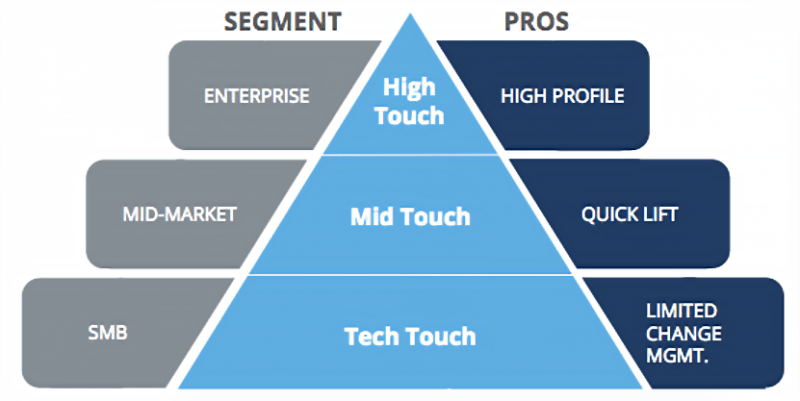This blog post was co-authored by Allison Pickens and Chris Doell. Allison Pickens is Chief Customer Officer at Gainsight. Chris Doell leads Customer Success for Cisco’s Cloud Security Division. Many thanks to Kelli Kirwin, now Director, Offer Monetization Office at Cisco, for her pioneering work in the area of Customer Success in the channel and for contributing to this post.
Customer Success at scale is much more than one-to-many email automation to engage the long tail of your customer base. Collaborating with your partner ecosystem on Customer Success can be another key to scaling.
When it comes to your partner ecosystem, it’s about alignment: specifically, alignment on the customer’s intended outcomes, on the touch points along the customer journey, and on incentives for the customer, vendor, and partner.
When alignment happens, every constituency wins. Customers derive quicker time-to-value that is consistent with standardized journey maps, vendors benefit with better margins due to reduced adoption costs, and partners not only increase their margins and retention rates, but also identify upsell/cross-sell opportunities and enhance their competitive position.
There’s an opportunity for a major paradigm shift in vendor-partner relationships — leading to an ecosystem that is aligned around the customer’s success. We’re observing the unfolding of a world where vendors and partners have:
- A shared responsibility for positive customer outcomes,
- A shared toolset and 360-degree view of the customer along their journey,
- Shared, trusted barometers for Customer Health (including NPS, adoption, advocacy, and other metrics), and
- Better alignment on prescribed customer journeys and the playbooks that make them happen.
Let’s reflect on that for a moment. The entire fabric of the vendor-partner relationship is going to change, as a result of the Customer Success movement.
Traditionally, most partners focus on transactional activity and measure it via margin preservation, top-line bookings, and services attach rates — often in that order. In the new paradigm, however, vendors will include their channel partners, alongside internal functional stakeholders (Support, Sales, Marketing, Product, CSMs, etc.), as another primary contributor in the journey toward customer success.
Further, vendors will be expecting their Channel to contribute to customer outcomes.
This is our vision of the future, but it’s a radical shift, and it won’t happen overnight. Many partners simply cannot invest in proactive, nurture-oriented team members without seeing proof of reward. So frankly, it’s the vendor’s responsibility to prove the value of the new paradigm and then extend it across a broader set of partners.
Start out with a couple of progressive partners, and once proven (as many of you have done internally!), you can “rinse and repeat” the model across a broader set of partners. Here’s our recommended playbook for working with partners to drive Customer Success:
- Profile Your Partners
- Define the ROI to the Partner
- Share Customer Insights
- Provide Enablement
- Define the Division of Labor
- Measure Partner Effectiveness
#1: Profile Your Partners
As vendors encourage their partners to roll out CS programs, they need to prioritize their time effectively across their partner ecosystem. Start with a small group – think 2-4. Hand-select them for success.
Vendors are prioritizing partners based on several factors:
- Are services a core part of their business model?
- Does the partner have a “lifecycle” or “adoption” practice?
- Do we expect that the partner would derive a strong ROI from investing in CS, due to e.g. enhanced cross-sell and upsell?
- Are there several people whose roles are focused on customer success or training?
- For larger partners:
- Is there an executive at the partner who is committed to Customer Success?
- Is there specifically a Customer Success executive, or just CSMs reporting to a Sales/Support/Operations executive?
Once you’ve got your small group, start a pilot. See what works well and what doesn’t. Then expand your list.
#2: Define the ROI to the Partner
Work with your prioritized partners to help them demonstrate that expanding their CS program is worth it. Most partners won’t do this on their own – it’s incumbent on you, as the vendor, to show the ROI.
There are four sources of ROI to a partner:
- Growth in Product Revenue, e.g. faster expansion into existing accounts, or reduced client attrition. Among recurring revenue businesses, ascending the Customer Success maturity curve can improve Gross Retention rates by 10-20 percentage points, and improve Net Retention rates by 20-30 percentage points. (We plan to write more about the Customer Success maturity curve in a future post.)
- Growth in Services Revenue.Many partners have razor-thin margins on re-selling the product. But their services business may generate a 30-40% margin. By offering Customer Success to its clients, a partner can become more deeply embedded with a client and better identify areas where services can add value for the client.
- New Revenue from Customer Success as a Service. Some vendors are launching paid CSM programs; some partners may do the same.
- Point of Differentiation in Attracting New Customers: A partner can stand out against others by offering a Customer Success program. Vendors can reinforce this differentiation by requiring partners to have a CS program in order to earn “Gold Status” or other designations.
Besides defining the ROI model, get a handful of partners to actually demonstrate ROI from rolling out a CS program. Get a small set of “early adopters” among partners to showcase the value to everyone else.
#3: Share Customer Insights
If you’re like most vendors, you’re “going digital” – you’re building 360-degree views of your clients, across usage data, NPS data, Support ticket data, Community portal data, and other types. That’s exactly what partners need in order to know which clients to follow up with, at what time, and for what reason.
It’s time to expose that data to your partners. Vendors are starting with the basics — e.g. emailing their partners lists of customers that have renewals upcoming in the next 30, 60, and 90 days — and then finding more systematic ways to expose other data types through Gainsight.
Information-sharing should be a two-way street. Vendors are eager to hear partners’ insights into their customers and can create systems to share that information. Vendors also want to hear their partners’ feedback on the playbooks above, and on the product itself.
#4: Provide Enablement
Besides receiving enablement in the form of ROI models and Customer Health data, partners need three additional types of support from you (the vendor):
- Training on Playbooks. What playbook would the vendor recommend the partner adopt when a customer is new? When adoption declines? When a renewal is coming up? What are the KPIs that the vendor is focused on, and how should the partner aim to achieve those?
- Certification. Vendors are planning to require that partners get certified on lifecycle management, adoption programs, or change management in order to attain certain status levels (e.g. “Gold Status”), as noted above.
- Partner Success Managers. Vendors can’t afford to provide these for all partners – they’re tiering their partners and allocating resources accordingly. The Vendor Account Manager role is starting to evolve into a Partner Success Manager role, analogous to the trend of more transactional Account Management teams evolving into Customer Success teams.
Some partners in particular need to raise their game, with the vendor’s help, because their paid adoption services may not be as robust as the free Customer Success that the vendor offers – which can result in channel conflict, with customers abandoning the partner.
Be thoughtful in rolling out these enablement programs, to ensure partners perceive these as a source of empowerment – i.e. bolstering the partner’s ownership of the client relationship – rather than an intrusion.
#5: Define the Division of Labor
Partners can extend your reach among SMB customers. When a vendor forms a Customer Success program, they’ll typically start by assigning CSMs to their Enterprise clients – the top tier of the client pyramid below. They often also assign CSMs to the Mid-Market segment, but may not have the budget to assign CSMs to the SMB segment. For many businesses, however, partners play within every tier of the customer pyramid.

Regardless of where vendor or partner resources are applied, it’s always important to understand who is doing what. For each segment, what do you expect your team to do? What do you expect partners to do? Be specific!
The key here is protecting your brand across the lifecycle, whether your team or a partner is taking the lead on an activity. You’ll want to make sure your partners are using messaging that’s consistent with and leaves a positive imprint on your brand.
#6: Measure Partner Effectiveness
Vendors want to hold partners accountable: they want visibility into their partners’ compliance with the recommended playbooks. They also want to see partners generate real value for customers.
In fact, many vendors are planning to pay partners based on their success in driving outcomes and growth in the installed base. Some vendors are starting simple, by paying partners based on renewals — not just new logos. Others are more advanced, paying their partners based on leading indicators of renewal and expansion, such as License Utilization, Active Users, or Client Health Score.
The proof is in the pudding. Whatever metrics you use, the effectiveness of the CS investment must be measured.
This evolved payment model makes Step 3 above (sharing customer data) even more important. Vendors and partners need a common system that’s a source of truth for the data that informs payments.
Furthermore, these KPIs should be mutually agreed upon in advance, reviewed together at regular intervals, and objectively measured to avoid the dreaded (and unproductive) “he said, she said” situation. While these steps require some effort and investment in a shared toolset, they’re critical to aligning the vendor, partner, and positive customer outcomes.
As we look into the future of the vendor-partner relationship, we should consider the possibility of a partner agreement with dynamic margin percentages based on targets for Customer Health metrics. These types of shared risk / shared reward business structures are a logical next step, once vendors and partners agree to invest together in their mutual customers’ success.
***
Vendor-partner alignment is one of the biggest trends we’re seeing in Customer Success. If you’re curious to learn more or if you want to share a success story, you can reach us at apickens@gainsight.com or cdoell@cisco.com.

